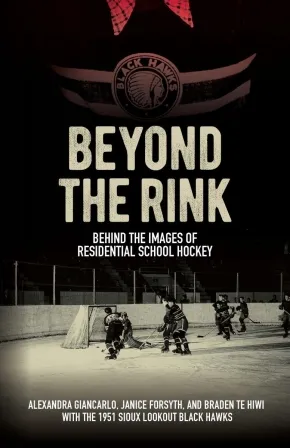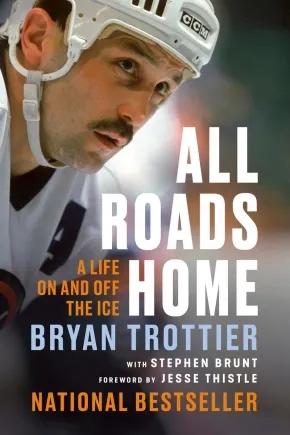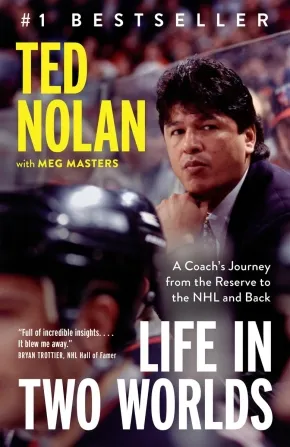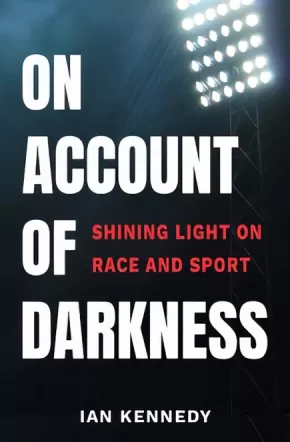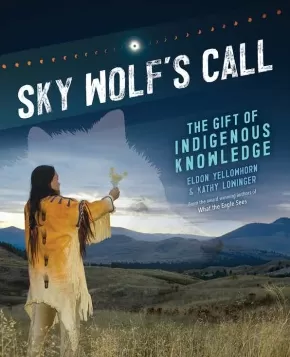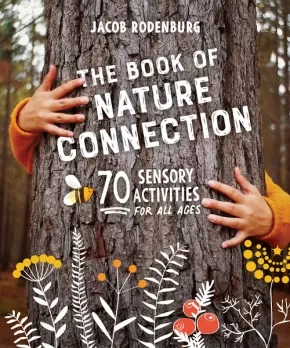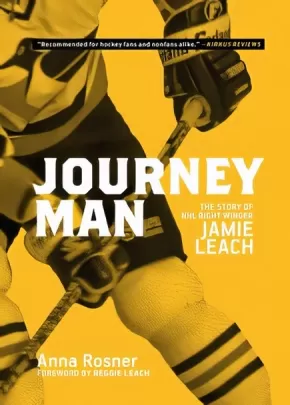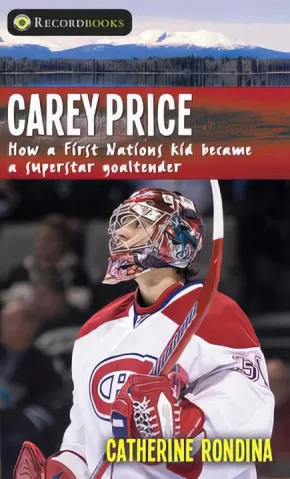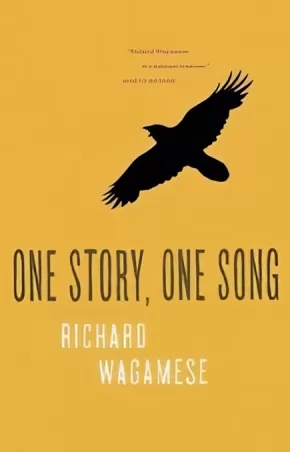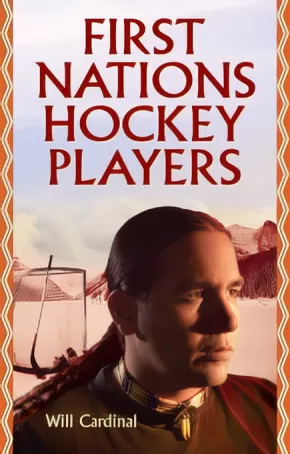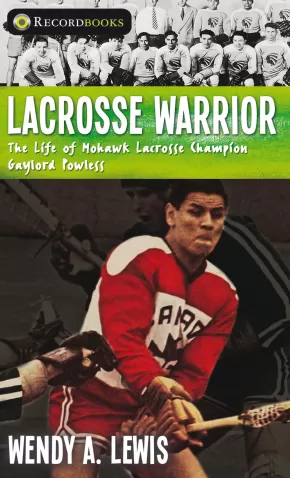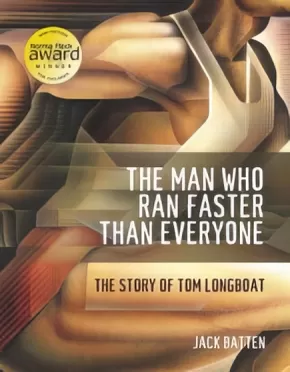Physical Education
Synopsis:
Teammates, champions, Survivors
In 1951, after winning the Thunder Bay district championship, the Sioux Lookout Black Hawks hockey team from Pelican Lake Indian Residential School embarked on a whirlwind promotional tour through Ottawa and Toronto. They were accompanied by a professional photographer from the National Film Board who documented the experience. The tour was intended to demonstrate the success of the residential school system and introduce the Black Hawks to "civilizing" activities and the "benefits" of assimilating into Canadian society. For some of the boys, it was the beginning of a lifelong love of hockey; for others, it was an escape from the brutal living conditions and abuse at the residential school.
In Beyond the Rink, Alexandra Giancarlo, Janice Forsyth, and Braden Te Hiwi collaborate with three surviving team members-Kelly Bull, Chris Cromarty, and David Wesley-to share the complex legacy behind the 1951 tour photos. This book reveals the complicated role of sports in residential school histories, commemorating the team's stellar hockey record and athletic prowess while exposing important truths about "Canada's Game" and how it shaped ideas about the nation. By considering their past, these Survivors imagine a better way forward not just for themselves, their families, and their communities, but for Canada as a whole.
Reviews
"These three survivors-Kelly, David, and Chris-inspire us not only for what they have done for their communities in the aftermath of the residential school system but also for how crucial hockey and sports are in bringing Indigenous communities together, like we see in the Little NHL Tournament. Our history and the lessons we've learned are vital, and Beyond the Rink does an excellent job of highlighting this." — Ted Nolan, former NHL Player & Coach, Olympic Coach, and author of Life in Two Worlds: A Coach's Journey from the Reserve to the NHL and Back
"On its face, Beyond the Rink is a compelling story of a residential school hockey team from northern Ontario touring Ottawa and Toronto in the 1950s. But it is much more than that: with a National Film Board photographer accompanying them every step of the way, the players are props in a public relations exercise meant to obscure the true conditions in residential schools.
This is an unflinching and nuanced look behind the PR veil, a story of loss, triumph, perseverance, tragedy, and memory. It is also a detailed account of the machinery of residential schools and the trauma they inflicted. And it is a revealing look at the power of photographs, which can be used to both illuminate and mislead.
At its heart, Beyond the Rink is the story of twelve Indigenous hockey players, who, like their white counterparts, loved the game for the thrill of competition, but also as an escape from the relentless control and exploitation they faced on a daily basis, even if they were being exploited while doing it. This is the story of twelve boys, told through the lens of three of them, trapped in a world they barely understood, a world that was not the least bit interested in understanding them, and in many ways still isn't." — Gord Miller
"The authors have spent decades working with the Survivors whose stories they share and centre in this book. Beyond the Rink, Behind the Image does not simply tell the story of a hockey team; it demonstrates how sport within the context of residential schools was a tool of colonization." — Karen Froman
"It is difficult to overstate the significance of this book. The scholarship is sound as well as original in context and content, and Survivor testimony is respected and communicated in a theoretically sophisticated way." — Travis Hay
Additional Information
184 pages | 6.00" x 8.50" | 36 b&w illustrations, bibliography | Paperback
Synopsis:
A poignant and inspiring memoir of the people and challenges that shaped the life and career of Canada's most decorated Indigenous athlete.
Over the course of his incredible career, Bryan Trottier set a new standard of hockey excellence. A seven-time Stanley Cup champion (four with the New York Islanders, two with the Pittsburgh Penguins, and one as an assistant coach with the Colorado Avalanche), Trottier won countless awards and is a member of the Hockey Hall of Fame and the Canadian Sports Hall of Fame. In 2017, he was named one of the NHL's Top 100 Players of All Time.
Trottier grew up in Val Marie, Saskatchewan, the son of a Cree/Chippewa/Metis father and an Irish-Canadian mother. All Roads Home offers a poignant, funny, wise, and inspiring look at his coming of age, both on and off the ice. It is a unique memoir in which Trottier shares stories about family, friends, teammates, and coaches, the lessons that he has learned from them, and the profound impact they have had in shaping the person he has become.
Some of the incredible characters featured in the book include Trottier's father Buzz; legendary Islanders coach Al Arbour; teammates Clark Gillies and Mike Bossy; and the Penguins' Mario Lemieux, to name but a few. He'll also talk about the high school English teacher and guidance counsellor who helped him develop self-confidence and encouraged him as a writer: Governor General's Award–winning poet, Lorna Crozier.
All Roads Home also includes a Foreword from bestselling author Jesse Thistle (From the Ashes) and two very special Afterwords: one from Trottier's daughter, Lindsy Ruthven, and the other from his life-long friend, beloved hockey great Dave "Tiger" Williams.
Additional Information
304 pages | 5.16" x 7.95" | Paperback
Synopsis:
In 1997 Ted Nolan won the Jack Adams Award for best coach in the NHL. But he wouldn’t work in pro hockey again for almost a decade. What happened?
Growing up on a First Nation reserve, young Ted Nolan built his own backyard hockey rink and wore skates many sizes too big. But poverty wasn’t his biggest challenge. Playing the game meant spending his life in two worlds: one in which he was loved and accepted and one where he was often told he didn’t belong.
Ted proved he had what it took, joining the Detroit Red Wings in 1978. But when his on-ice career ended, he discovered his true passion wasn’t playing; it was coaching. First with the Soo Greyhounds and then with the Buffalo Sabres, Ted produced astonishing results. After his initial year as head coach with the Sabres, the club was being called the “hardest working team in professional sports.” By his second, they had won their first Northeast Division title in sixteen years.
Yet, the Sabres failed to re-sign their much-loved, award-winning coach.
Life in Two Worlds chronicles those controversial years in Buffalo—and recounts how being shut out from the NHL left Ted frustrated, angry, and so vulnerable he almost destroyed his own life. It also tells of Ted’s inspiring recovery and his eventual return to a job he loved. But Life in Two Worlds is more than a story of succeeding against the odds. It’s an exploration of how a beloved sport can harbour subtle but devastating racism, of how a person can find purpose when opportunity and choice are stripped away, and of how focusing on what really matters can bring two worlds together.
Reviews
"Full of incredible insights into a tough life that Teddy’s perseverance turned into inspiration. It blew me away.”—Bryan Trottier, NHL Hall of Famer
“Ted’s beautiful memoir follows a trail of losses and the pain of getting well, and his stunning successes, lifting trophies, lifting lives. Ted was able to reach so many things, but his truth went beyond these things, and it’s the story of how he went beyond, to keep what was true in front of him that makes this book so enjoyable, and so important.”—Ron MacLean, CBC sportscaster and host of Hockey Night in Canada
“Ted Nolan’s story is truly remarkable. Ted persevered and overcame significant obstacles at a time when Indigenous people were not encouraged, applauded, or even wanted in elite hockey leagues. Ted broke barriers, battled racism, worked hard, and not only became an NHL player but also an elite junior, NHL, and international coach. Ted paved the way for many Indigenous youth to not only participate, but succeed in hockey arenas across North America and Europe as coaches and players.”—Phil Fontaine, former National Chief of the Assembly of First Nations
“Playing for Ted Nolan is one of my fondest memories. People called us “The Hardest Working Team in Hockey” and that doesn’t happen without a coach who can show each player their purpose and prove his belief in them. We all played beyond our own abilities for Ted. We led the NHL in penalty minutes and no team wanted to play us in our building. I respect Ted as a coach both on and off the ice, and this book gives a hint of why he inspires that in players and in people in general.”—Rob Ray, broadcaster and former NHLer
“Teddy was my favourite coach, mentor and friend. I love Ted Nolan. This book gives a good sense of what makes him so special.”—Brad May, former NHLer, Stanley Cup winner, and AT&T SportsNet analyst
“My father was so proud of Ted; he understood what he was going through. A story of perseverance, Life in Two Worlds is a great read for any generation."—Neil Sasakamoose, son of Fred Sasakamoose, the NHL’s first Treaty Indigenous player and bestselling author of Call Me Indian
Additional Information
336 pages | 5.11" x 7.97" | 8-page colour insert | Paperback
Synopsis:
Following the bestselling success of the inspiring All the Way, pioneering Inuit NHLer Jordin Tootoo begins the process of healing in the wake of the suicide and violence that marks his family, only to discover the source of all that trauma in his father's secret past.
For some hockey players, retirement marks the moment when it’s all over. But Jordin Tootoo is not most hockey players.
Having inspired millions when he first broke into the league, Tootoo continued to influence people throughout his career—not only through his very public triumph over alcoholism, but also his natural charisma. And now, years after hanging up his skates, he is more committed to doing things the right way and speaking about it to others, whether it’s corporate executives or Indigenous youth.
But the news of unmarked graves on the grounds of residential schools brought back to life many of the demons that had haunted his family. In a moment of realization that left him rattled and saddened, Tootoo fit the pieces together. The years that were never spoken of. The heavy drinking. The all too predictable violence. His father was a survivor, marked by what he had survived.
As he travels back to Nunavut to try to speak with his father about what haunts him, he encounters the ghosts of the entire community. Still, as Tootoo says, we are continuously learning and rewriting our story at every step. He has learned from his mistakes and his victories. He has learned from examples of great courage and humility. He has learned from being a father and a husband. And he has learned from his own Inuk traditions, of perseverance and discipline in the face of hardship.
Weaving together life’s biggest themes with observations and experiences, Jordin shares the kind of wisdom he has had to specialize in—the hard-won kind.
Additional Information
208 pages | 6.20" x 9.37" | Hardcover
Synopsis:
For marginalized athletes past and present, achievement can bring celebrity without equality and recognition without opportunity.
In many ways, Ontario’s Chatham-Kent region is a microcosm of Canadian multiculturalism. As a terminus of the Underground Railroad, it has long been home to a large Black community, Walpole Island and Delaware First Nations are nearby, and many interned Japanese Canadians worked on local farms during World War II. The history of sport in the region is emblematic of the challenges that have confronted generations of non-white athletes nationwide. Each chapter uses the story of a local athlete—some famous, others more obscure—to illuminate one aspect of the evolving relationship between race and sport in North America. Combining tales of personal triumph with sports history and social commentary, On Account of Darkness examines systemic racism and ambivalent attitudes that persist to this day.
Additional Information
256 pages | 5.50" x 8.50" | Paperback
Synopsis:
From healing to astronomy to our connection to the natural world, the lessons from Indigenous knowledge inform our learning and practices today.
How do knowledge systems get passed down over generations? Through the knowledge inherited from their Elders and ancestors, Indigenous Peoples throughout North America have observed, practiced, experimented, and interacted with plants, animals, the sky, and the waters over millennia. Knowledge keepers have shared their wisdom with younger people through oral history, stories, ceremonies, and records that took many forms.
In Sky Wolf’s Call, award-winning author team of Eldon Yellowhorn and Kathy Lowinger reveal how Indigenous knowledge comes from centuries of practices, experiences, and ideas gathered by people who have a long history with the natural world. Indigenous knowledge is explored through the use of fire and water, the acquisition of food, the study of astronomy, and healing practices.
Reviews
"An authoritative tribute to Indigenous knowledge systems that's a must-have for every library and classroom." - Kirkus Reviews
“Sky Wolf’s Call has an astoundingly broad scope introducing Indigenous Traditional Ecological Knowledge (TEK) in North America from time immemorial to the current day … This fast paced celebration of Indigenous innovation and technology is riveting.” - The British Columbia Review
Educator Information
Interest Age: 11+
Grade: 6+
Reading Age: 11+
A Junior Library Guild Gold Standard Selection
Table of Contents
Author’s Note
1: Sky Wolf’s Call: The Gift of Indigenous Knowledge: Foundational ideas behind Indigenous Knowledge and the importance of retaining, maintaining, and learning this sacred knowledge.
2: Water Knowledge Ways: Water links us all and is sacred. Indigenous people have fought to protect the gift of water from harm, and the critical role it has played in transportation, agriculture, irrigation, and food.
3: Fire and Smoke Knowledge: Fire and smoke are great gifts, including the burning of tobacco. In sacred ceremonies, smoke connects our breath with the heavens. Fire cooks our food, helps grow our crops, and even keeps our waters clean. Cultural burns are used to benefit the land.
4: Indigenous Knowledge and Food Security: Sharing, growing, and receiving food with family, community, and visitors is both an honour and a tradition. By understanding the traditional practices of salmon fishing, clam gardens, planting and harvesting certain crops, or hunting buffalo, Indigenous Peoples have respected what Mother Earth has to offer.
5: Healing Knowledge Ways: The use of the medicine wheel and the sweat lodge have been used over centuries and still help sick and troubled people. Games such as lacrosse and chunkey have helped in building individual strength and community spirit. And braiding together Indigenous healing and western science has opened new learning opportunities.
6: Sky Knowledge: From the earliest Indigenous astronomers to modern astrophysicists, these sky watchers have studied the sacred gifts of the sky: the sun, moon, planets, and stars that have produced maps, calendars, beliefs about how to govern, and even directions for building homes.
7: Keeping the Knowledge: Indigenous People hold oral narratives in high esteem because that was the way knowledge passed from one generation to the next. People in North America recorded important events with symbols, pictographs (paintings), and petroglyphs (carvings). Language Keepers and Knowledge keepers are making sure that Indigenous knowledge is never forgotten.
8: Sky Wolf’s Call: Indigenous knowledge is based on the idea that this world is a gift. Understanding the idea of connections (the skies with the earth, people with animals, the practical with the spiritual) is an important lesson with the challenges of climate change, pandemics, and wars. The wisdom of Indigenous Knowledge can help the whole world.
Thanks and Acknowledgments
Glossary
Selected Reading
Sources and Contacts
Additional Information
120 pages | 7.50" x 9.25" | Paperback
Synopsis:
Unplug from technology and "plug in" to nature through the wonder of your senses.
The Book of Nature Connection is packed with fun activities for using all our senses to engage with nature in a deep and nourishing way.
From "extenda-ears" and acorn whistles to bird calls, camouflage games, and scent scavenger hunts, enjoy over 70 diverse, engaging, sensory activities for all ages that promote mindfulness and nature connection.
With activities grouped by the main senses – hearing, sight, smell, touch, and taste – plus sensory walks and group games, The Book of Nature Connection is both a powerful learning tool kit and the cure for sensory anesthesia brought on by screen time and lives lived indoors.
Whisper in birds, be dazzled by nature's kaleidoscope of colors, taste the freshness of each season, learn to savor the scented world of evergreens, hug a tree and feel the bark against your cheek. Spending time in nature with all senses tuned and primed helps us feel like we belong to the natural world – and in belonging, we come to feel more connected, nourished, and alive.
Ideal for educators, camp and youth leaders, caregivers and parents, and anyone looking to reconnect and become a nature sommelier!
Additional Information
128 pages | 7.50" x 9.00" | Colour photos throughout | Paperback
Synopsis:
Journeyman is a first-person biography of Ojibwe rightwinger Jamie Leach, son of the legendary NHL superstar Reggie Leach. Follow the fascinating hockey trajectory from his childhood years watching his father play for the Philadelphia Flyers, to Jamie’s first goal in the NHL.
Journeyman touches on Jamie’s summers on Lake Winnipeg, the World Junior Hockey Championships, his life in the minor leagues, and his eventual draft into the NHL as a Pittsburgh Penguin. Discover how some of hockey’s biggest stars such as Bobby Clarke, Jaromir Jagr, and Mario Lemieux influenced Jamie’s life.
Written in close consultation with Jamie and his mother, readers will learn about the struggles Jamie conquered, including his father’s alcoholism and his own crippling self-doubt.
A story of determination, heartbreak and perseverance.
Reviews
"This straightforward, inspiring account goes down easy and should appeal to most kids, especially skaters looking for role models." —Booklist
Educator Information
Recommended by the publisher for middle-grade readers 10+.
Forward by Reggie Leach.
Additional Information
104 pages | 5.00" x 7.00"
Synopsis:
This book highlights the achievements of Canadian women sports stars — the role models of today's young female athletes. They fought for the right to compete in sports traditionally dominated by men and proved that women's sports are just as competitive and exciting to watch as men's. Spanning decades, Breaking Through focuses on seven sports and the women who made them their own, including well-known legends such as soccer player Christine Sinclair, who brought women's soccer in Canada into the limelight, and hockey player Hayley Wickenheiser, the longest-serving member of Canada's National team and five-time Olympic medalist. Readers will also see basketball, bobsleigh and rugby represented and learn the stories of less well-known athletes such as Indigenous Cross-country skiers Sharon Anne and Shirley Firth, who faced down prejudice, and Carol Hunyh, who brought home Canada's first Olympic gold medal in women's wrestling.
Educator & Series Information
Recommended Ages: 12-18.
Some, but limited, Indigenous content.
This work is part of the Recordbooks series, which includes sports biographies that highlight key social issues for reluctant readers.
Additional Information
144 pages | 4.25" x 7.00"
Synopsis:
Twenty years ago, Carey Price was flying 319 kilometres across British Columbia in his father's plane so he could play on the nearest organized hockey team. Today, he is the highest-paid goalie in the NHL. But he's never forgotten where he started.
The son of an NHL draftee and the chief of the Ulkatcho First Nation, Carey got his start on skates as a toddler, first on a frozen creek and then on his father's homemade rink. The natural athlete went on to become the top amateur player in Canada in 2002, getting drafted fifth overall by the Montreal Canadiens three years later. Now one of the most recognizable figures in hockey, Carey credits his success to his community of Anahim Lake, where hard work and commitment often face off against remoteness and cost. Throughout his incredible career, he's taken every opportunity possible to encourage all young people, especially those who share his Indigenous background, to follow their dreams.
Reviews
"The book is aimed at middle-grade readers, ages 12+, and has a decidedly different approach to telling his remarkable story. For one, author Catherine Rondina chose to really spotlight Price's Indigenous background ... The pocketbook from Lorimer's RecordBooks series crams a lot into its 150 pages, from Price's early days in the remote Anahim Lake, B.C., to leading Canada to a gold medal at the 2014 Olympic Games in Sochi."— Greg Oliver, Society for International Hockey Research, June 2018
"This slim, pocket-size biography manages to convey an awful lot of information through engaging, brief chapters and breezy vocabulary. Readers will come away with an overview of acclaimed goalie Carey Price's hockey career to date."— Kathleen McBroom, Booklist, August 2018
"An inspiring story, especially for hockey fans and not just for reluctant teen readers."— Kirkus Reviews, May 2018
"A short and captivating peek into a remarkable athlete's life for middle schoolers."— School Library Journal, October 2018
Educator & Series Information
Hi-Lo Book.
Interest age: From 12 To 18
Fry Reading Level [grade]: 3.5
Lexile Reading Level: 890L
This book is part of the Recordbooks Series. Recordbooks help reluctant readers understand social issues through the lens of a true story of a sports hero.
Series features:
- Ideal for reluctant readers
- Hi-lo
- Short chapters, easy-to-read format
- Great for ESL and adult students
- Writing with a flair for making history feel like novels
- Accompanied by historical photos and sports trivia
- Ideal for ages 12+
Additional Information
152 pages | 4.25" x 7.00"
Synopsis:
“The Gabriel Dumont Institute Press is pleased to be able to preserve and share Jeanne Pelletier’s work and life story through Let Me See Your Fancy Steps—Story of a Métis Dance Caller. The Story of Jeanne Pelletier as told to Sylvie Sara Roy and Wilfred Burton. Jeanne’s achievement as the first female Métis dance caller is, of course, about Métis dance, but it is also about the determination of a young Métis girl who achieves her dream to become a dance caller during a time when this was only done by men.”
This resource includes dance calls for 16 dances and is accompanied by the instructional DVD All My Relations which features dance company V’ni Dansi which is led by renowned dancer and artistic director, Yvonne Chartrand.
Reviews
"The recounting of Jeanne’s work is supplemented throughout the book by testimonials of her former dance students and community members, all of whom praise the dance caller for the substantial impact that she’s had both on their personal lives, as well as the academic and social climates of the Métis community in Saskatchewan. As a Métis myself, I feel lost at times, as if my culture is fuzzy or foreign to me. Reading the life experiences, knowledge, and not to mention the wealth of Métis Jig steps found in this book gave me an overwhelming sense of peace to see research of this caliber and this level of care being invested in my culture. I would highly recommend this book to anyone with an interest in Métis culture and the significance that the jig has to the culture. Anyone who has seen the Métis Jig performed live knows that it is a beautiful and awe-inspiring dance, but after reading Jeanne’s explanations of the cultural significance of the dances, I will now appreciate the dance that much more as a story and celebration of my culture. It is also worth mentioning that entire dance sequences are written out to follow with Jeanne’s notes, and the book includes an instructional DVD." - Ben Charles for SaskBook Reviews
Educator Information
Recommended by Gabriel Dumont Institute for Secondary/Post Secondary/Adult.
Includes a DVD.
Recommended in the Canadian Indigenous Books for Schools 2019-2020 resource list as being useful for grades 5-12 with regard to these subjects: English Language Arts, Physical Education, Social Studies, Teacher Resource.
Synopsis:
A collection of warm, wise and inspiring stories from the author of the bestselling One Native Life.
Since its publication in 2008, readers and reviewers have embraced Richard Wagamese's One Native Life. In quiet tones and luminous language,wrote the Winnipeg Free Press, Wagamese shares his hurts and joys, inviting readers to find the ways in which they are joined to him and to consider how they might be joined to others.
In this book, Richard Wagamese again invites readers to accompany him on his travels. This time, his focus is on stories: how they shape us, how they empower us, how they change our lives. Ancient and contemporary, cultural and spiritual, funny and sad, the tales are grouped according to the four Ojibway storytelling principles: balance, harmony, knowledge and intuition.
Whether the topic is learning from his grade five teacher about Martin Luther King, gleaning understanding from a wolf track, lighting a fire for the first time without matches or finding the universe in an eagle feather, these stories exhibit the warmth, wisdom and generosity that made One Native Life so popular. As always, in these pages, the land serves as Wagamese' guide. And as always, he finds that true home means not only community but conversation good, straight-hearted talk about important things. We all need to tell our stories, he says. Every voice matters.
Reviews
"One Story, One Song is a collection of short stories that show how stories shape & empower us, and change our lives. The stories are grouped according to the 4 essential principles of the Ojibway traditional teachings: humility, trust, introspection, and wisdom." - The Dalai Lama Center
Additional Information
216 pages | 5.52" x 8.50" | Paperback
Synopsis:
People of the Mi'kmaq Nation in Nova Scotia were playing a type of ice hockey in the late 1600s. Over the centuries, the role of the First Nations in that sport has been marked by innate ability, enthusiasm and many challenges.
Sandy Lake Cree member Fred Sasakamoose of the Chicago Blackhawks was the first Native to play in the National Hockey League. His achievements were the beginning of a proud history of First Nations hockey players who became NHL heroes on and off the ice.
FIRST NATIONS HOCKEY PLAYERS tells the stories of these great players, Inuit, Ojibwa, Mohawk, Métis, Mi'kmaq, Cree and many other NHL stars with First Nations roots, are highlighted along with current players such as Jonathan Cheechoo, Carey Price, Sheldon Souray and Jordin Tootoo. The book also features tales of hockey greats such as Bryan Trottier, Reggie Leach, Stan Jonathan, Theoren Fleury and Grant Fuhr.
Synopsis:
Gaylord Powless was playing lacrosse by the age of three. He descended from generations of Mohawk lacrosse players and possessed great skill, but his native ancestry made him the target of brutal checking, and slashing. This is a compelling story of how this champion learned to deal with emotions.
Ideal for reluctant readers.
Educator & Series Information
Recommended Ages: 12-18.
Fry Reading Level: 4.5
This book is part of the Recordbooks Series. Recordbooks help reluctant readers understand social issues through the lens of a true story of a sports hero.
Series features:
- Ideal for reluctant readers
- Hi-lo
- Short chapters, easy-to-read format
- Great for ESL and adult students
- Writing with a flair for making history feel like novels
- Accompanied by historical photos and sports trivia
- Ideal for ages 12+
Additional Information
120 pages | 4.25" x 7.00"
Synopsis:
Tom Longboat was a hero. A member of the Onondaga Nation, he was born on the Six Nations reserve in Oshwegen, near Brantford, Ontario. Despite poverty, poor training, and prejudice, Longboat went on to become one of the world’s best runners. In 1907, at the height of his fame, he won the Boston Marathon and ran in the 1908 Olympic Marathon. Longboat was one of the best-known people of his day, and certainly the most prominent member of the Six Nations. Throughout his career he had to race against opponents, as well as rumors of illegal running activities. Nevertheless, he maintained his dignity, and his achievements still inspire people who understand the great pleasure of running, and running fast.
Educator Information
Recommended for ages 10+
Additional Information
112 pages | 6.98" x 8.93"

